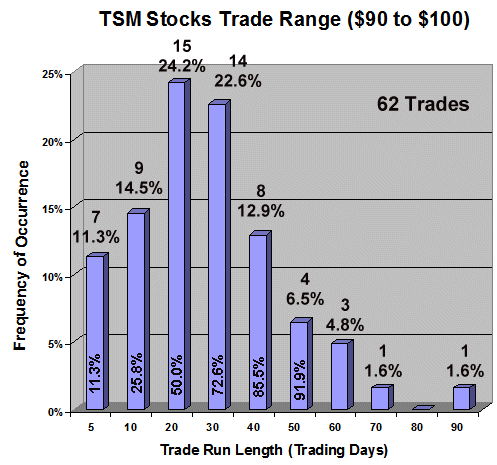TripleScreenMethod.com
Trading Patterns for Stocks of Fundamentally Sound Companies: The $90 to $100 Trading Range
from www.CANSLIM.net (published January 2007)
Richard W. Miller, Ph.D.
I classify short-term stock trading into two broad categories, and it doesn’t matter whether one chooses to focus intra-day, multi-day or even multi-week time frames: (1) trading strategies or patterns regardless of the fundamental quality of the underlying stock, or (2) restricting the trading of those same strategies or patterns to stocks of companies with strong fundamentals. I prefer the latter, techno-fundamental trading approach to trading historically proven patterns (like breakouts or pullbacks) because longer-term oriented, institutional traders sit ready to buy stocks supported by quality fundamentals, especially as their market capitalization grows. This is particularly true at breakouts from periods of consolidation or pullbacks to support levels. Since these institutional traders account for as much as 80 percent of the market’s trading volume, it only makes sense to swim with their current.
Over the past four years, I‘ve published several articles in CANSLIM.net News regarding the trading of stocks from fundamentally sound companies: “Buying CANSLIM Stocks in Multi-Day Pullbacks” (Dec ’03), “Augmenting IBD’s Quality Fundamental Analyses with Estimates of Value” (Jun ’04), “Buying Quality Stocks in Today’s Market: Pullbacks Versus 21-Day New Highs and 21-Day New Lows” (Oct ’04), “Trading Quality Stocks in Today’s Market: Buying 21-Day Lows of Fundamentally Sound Stocks” (Nov ’04), “The “Hammer” Candlestick Offers Investors a Profitable Entry” (Mar ’05), “Trading Fundamentally Sound Stocks on Pullbacks” (Sep ’05), and “Trading Breakouts and Pullbacks in Today’s Environment” (Oct ’05). Today, I want to discuss another, the likelihood of a stock (especially one supported by quality fundamentals), once it reaches $90, to run to $100. Common trading lore says that the $100 target acts as a price magnet. If that’s true, it should be even more so for our TripleScreenMethod (TSM) stocks.
As a data base, I assessed the $90-to-$100 run tendencies over the 2002 through 2006 period for the stocks generated through weekly TSM screens during 2006 (several hundred stocks). TSM methodology classifies stocks through a series of screens based on a combination of CANSLIM-like fundamentals, earnings revision fuel and remaining value. It’s a watch list of fundamentally sound stocks ripe for a bullish move.
Once a stock’s price reached $90, three things can happen: (1) it could run up to $100 quickly, say within the next 20 trading days; (2) it could consolidate longer, say the next 50 trading days, before reaching $100; or (3) it could fall back. Occasionally, a price would run to $90 then the stock would split before it reached $100. So long as the $90 trigger price was hit, the price run was counted as successful if the split-adjusted price reached the equivalent of $100, e.g., when a stock spilt 2-for-1 after hitting $90 pre-split, the target became $50.
Ninety-three trade opportunities were found. Of those, 67 reached $100 after being triggered at $90; eight were still active but hadn’t reached $100 yet; and 18 failed to reach the $100 target. Overall, 78.8 percent (67/85) reached target. So what’s the significance of this finding? That is, if there is no tendency to run from $90 to $100, i.e., a 50/50 chance that the run won’t happen, what’s the chance that we randomly observe 67 of 85 making that run? That’s easily calculated from the binomial distribution as 1 chance in 32,065,406. It’s a virtual certainty that fundamentally sound stocks have a tendency to run to $100 once the $90 trigger has been hit. So how should we trade that likelihood?
First, let’s incorporate a 10 percent stop-loss limit, i.e., if the $90 trigger is hit then price drops to $80.94 (no stops on whole dollar amounts), we’re out regardless of fundamentals. Now, 62 trades were completed successfully and another 5 remain active (ATI, IRE, LVS, MER, SNP). The chart shows the trade-life distribution for completed trades. Note, cumulative percentages are depicted on the bars, i.e., ~92 percent of the trades were completed within a 50-day period.
Trading $90 stocks is an expensive business, especially if you’re used to trading lots of 300 to 1,000 shares. If instead, one trades a deep in the money call, say the $70 call expiring in 60 days, the cost is similar to trading a $20 stock, and the option’s price moves nearly dollar-for-dollar with its underlying stock’s price movement. Just make sure that there’s enough volume in the option trade so the bid/ask spread is less than 50 cents, and continue to use the underlying stock’s price to set a stop-loss limit.
Find the complete data set of trades in the Excel table here.
